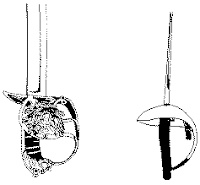 "It is particularly incumbent on those who never change their opinion, to be secure of judging properly at first." -Pride and Prejudice
"It is particularly incumbent on those who never change their opinion, to be secure of judging properly at first." -Pride and Prejudice
"Has it got any sports? ""Fencing, Fighting, Torture, Revenge, Chases, Escapes, Miracles, True Love." "I'll try to stay awake."
 "It is particularly incumbent on those who never change their opinion, to be secure of judging properly at first." -Pride and Prejudice
"It is particularly incumbent on those who never change their opinion, to be secure of judging properly at first." -Pride and Prejudice

 A Bout in 1760 in the Salle of Domenico Angelo.
A Bout in 1760 in the Salle of Domenico Angelo.  Foil Fencing in the 19th Century
Foil Fencing in the 19th Century Modern Foil Target (Note: the bib is incorrectly shaded as off-target)
Modern Foil Target (Note: the bib is incorrectly shaded as off-target) Fencing is really a romantic sport, originating in the duel of honor and gradually transformed into an intellectual game of outwitting your opponent.
Fencing is really a romantic sport, originating in the duel of honor and gradually transformed into an intellectual game of outwitting your opponent.Fencing, the art and science of swordplay, consists of three main areas:
Post-modern fencing is the purview of the US Fencing Association (USFA) and theFederation Internationale d'Escrime (FIE), the two governing bodies for national and international (respectively) competitive fencing that is electrically scored. This is the type of fencing that is featured on cable sports channels such as ESPN2 on rare occasions in this country. It is also the type of fencing that is done at the Summer Olympics every four years. It is very fast and very athletic. The weapons used are the foil, the epee, and the saber.
Historical/classical fencing is practiced by a number of small groups all over the United States and in other countries as well. The weapons used vary widely, but include rapier, broadsword, sword and dagger, single stick, and others, as well as the foil, sabre, and epee. The approach is that of a martial art -- not a sport -- supported by research into past fencing practices. Competitions are unusual. The closest thing to a governing body is a fledgling organization called the Association for Historical Fencing (AHF). The Society for Creative Anachronism (SCA) also engages in historical fencing (with degrees of historical accuracy that vary widely). Historical fencing tends to be slower and more deliberate, with a heavy emphasis on bladework and form. The period covered by historical fencing ends roughly in 1900.
Modern/classical fencing is practiced by an increasing number of fencing clubs throughout the United States. Because "classical fencing" increasingly refers to 19th-century historical fencing, we are beginning to use the term "modern fencing" and "standard fencing" to (hopefully) avoid confusion. The governing body of standard fencing is the American Fencing League (AFL).
Modern fencing is both a sport and a martial art, with roots in the traditions of European dueling. It supports both competitive and purely recreational fencing. The pace of modern fencing, which de-emphasizes pure athletic ability, is somewhat slower than postmodern fencing, but faster than historical fencing, making it an excellent spectator sport. And modern fencing is a great aerobic, co-ed activity that can be participated in by people from age 12 to 60+.
The weapons used are the standard (non-electric) foil, saber, and epee, as well as the electrical epee. The rules are similar to those of post-modern fencing, with the main exception being the scoring system. All scoring is either on the honor system (recreational) or by a jury (competitive) -- no electrical scoring apparatus is used, except in epee. There is a strong emphasis on form and clarity. The principle of right-of-way (or the priority of touches) is strongly maintained. Touches must be made in a manner that is consistent with the use of a sharp weapon -- even though the weapons are blunt.
In short, modern fencing is fencing from the first half of the 20th century blended with the knowledge of the second half of the 20th century. It is a different sport from postmodern fencing, with different rules and a different mindset. Modern fencing does not attempt to recreate a bygone era. Instead, it firmly maintains its roots in history, while simultaneously looking forward.
 1. The Three Musketeers, Alexandre Dumas.
1. The Three Musketeers, Alexandre Dumas.














